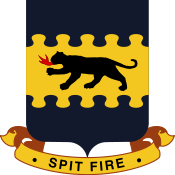Spann Watson

| Spann Watson | |
|---|---|
| Born | August 14, 1916 |
| Died | April 15, 2010 (aged 93) |
| Allegiance | United States of America |
| Service/branch | United States Army Air Forces |
| Years of service | 1941–1964 |
| Rank | Lieutenant Colonel |
| Unit | 332d Fighter Group |
| Battles/wars | World War II |
Lt. Col Spann Watson (August 14, 1916 – April 15, 2010) was a Tuskegee Airman serving in World War II. He flew over 30 missions for the famed squadron over North Africa, Italy and Southern Europe. On March 2007, Watson attended a ceremony in the U.S. Capitol rotunda, where he and other surviving veterans of the Tuskegee Airmen (and their widows) were honored with the Congressional Gold Medal in recognition of their service. He died on April 15, 2010 aged 93.[1]
Biography
Early life
Spann Watson spent his early life on the family farm outside Johnston, South Carolina. In 1927, the family moved north to Lodi, New Jersey, where he completed his primary and secondary education. In 1937, he enrolled at Howard University as a Mechanical Engineering student and earned a private pilot’s license.
Military service
He helped break the US Army Air Corps color barrier, enlisting as a Flying Cadet in November 1941. Completing pilot training at a segregated Tuskegee Army Air Field, in Tuskegee, Alabama in 1942, he became an original member of the 99th Fighter Squadron, the first group of Tuskegee Airmen to fight in World War II and the forerunner of the 332nd Fighter Group.
In April 1943, he was among the first 27 pilots (classes 42C – 42H) of the 99th Fighter Squadron commanded by then Lt Col Benjamin O. Davis, Jr., deployed to Casablanca. On June 9, 1943, as a member of a flight of six P-40s, led by 1st Lt Charles Dryden, he participated in World War II’s first aerial combat engagement between black Americans and the Luftwaffe. He flew combat missions with the 99th, flying P-40’s from North Africa, Sicily and the Italian mainland. Returning to the United States as an instructor pilot in the newly formed 332nd Fighter Group, he flew the P-39, P-47, P-51 and B-25 at Selfridge Field, Michigan, Walterboro AAF, South Carolina, Godman Field, Kentucky, Freeman Field, Indiana and Lockbourne AFB, Ohio. While at Freeman Field, he participated in the “Freeman Field Mutiny” against segregated base facilities. After the war, he served as the 99th’s Operations Officer until the 332nd was disbanded with the integration of the Air Force in 1949. Later assignments included Manager, Air Traffic Control Facilities, Hawaii and Chief Controller for Air Defense Control Centers in Long Island, New York, Misawa, Japan and Taipei, Taiwan. In 1962, he became Director, Air Defense Center, Stewart Air Force Base in Newburgh, New York, and in 1963, Team Leader, Regional Air Inspector General’s Office, Northeast, also at Stewart.
Spann’s Air Force career lasted over 23 years, during which he qualified as a Command Pilot and accumulated over 5000 flight hours. He retired from active duty as a Lieutenant Colonel on December 1, 1964. His decorations, awards and commendations include the Air Medal with 2 Oak Leaf Clusters, Air Defense Medal, Legion of Merit, Distinguished Service Medal, and the Army Commendation Medal.
Civilian aviation career
In 1965, he began a 27-year civilian career with the Federal Aviation Administration (FAA), initially serving as an Equal Opportunity Specialist and later as a Senior Air Traffic Specialist and Military Air Traffic Liaison. During his time at FAA, he mentored military and civilian aviation professionals and assisted more than 30 African-Americans who went on to attain appointments to Annapolis, West Point or the Air Force Academy. He retired from the FAA on August 3, 1992.
Tuskegee Airmen, Inc.
He was a founding member and two-term president of the Tuskegee Airmen Incorporated, and a signatory of its Articles of Incorporation.
Awards
He was a past president of the Air Force Association (AFA) and a member of the Thomas W. Anthony chapter, receiving the AFA’s Presidential Citation. In 1981 he received the National Coalition of Black Federal Aviation Employees’ Chief Anderson Award. In 1990 he was the first black American named an Elder Statesman of Aviation by the National Aeronautics Association (NAA) and was later elected to several terms on the NAA Board of Directors. In 1991, he received the Tuskegee Airmen’s highest honor, the Brigadier General Noel F. Parrish Award, and was honored by the Congressional Black Caucus in Washington, DC.
Other awards and recognition include the NAA’s Henderson trophy for lasting contributions to the promotion and advancement of aviation and the Congressional Gold Medal for service as a Tuskegee Airman. He was awarded honorary Doctorates of Humanities from Rhode Island College (1994), Tuskegee University (2006) and the State University of New York (2008).
